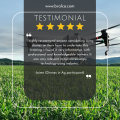I highly recommend anyone considering using drones on their farm to undertake this training. I found it very informative, with professional and knowledgable trainers. It was very relevant in our increasingly technology-using industry.
Jaime, Drones in Ag Participant
This event was inspirational for school students who are in the middle of experiencing bullying situations every day.
JSCHS Teacher,
The passion that Brooke from UpGen has for agriculture and future generations was shared with students who were prompted to begin thinking about their potential career path and what opportunities lie ahead for them. Beginning conversations about careers at a young age is essential to start students' journey of self discovery, spark their imagination and ignite important conversations about workplace culture because these students are our future.
Agriculture and Science Teacher,
It was so refreshing to hear young women talk about real life strategies to deal with bullying.
JSCH Student,



